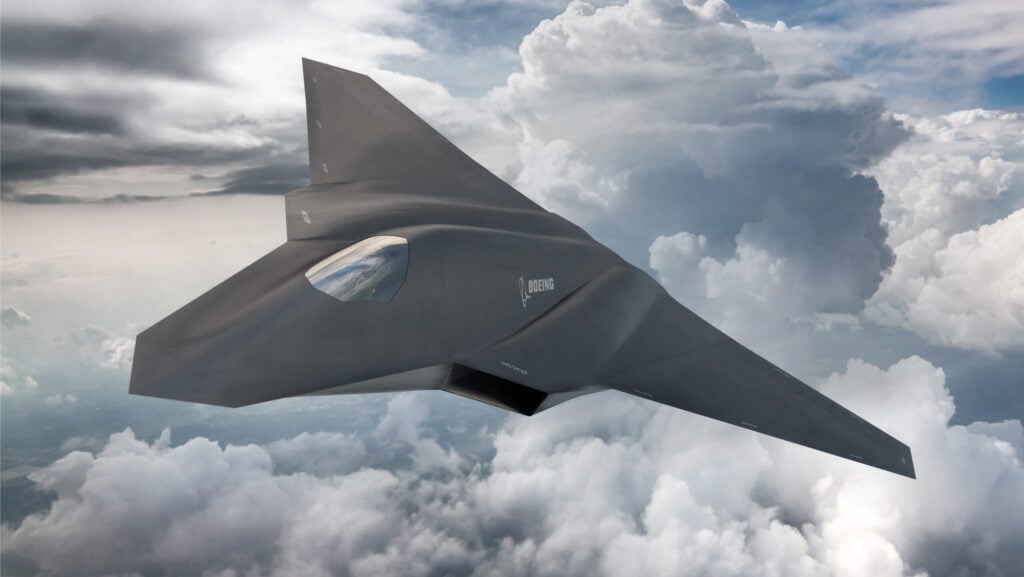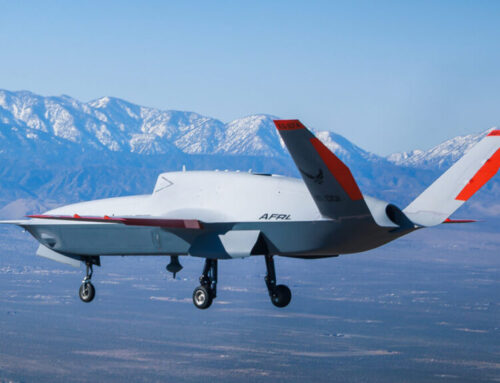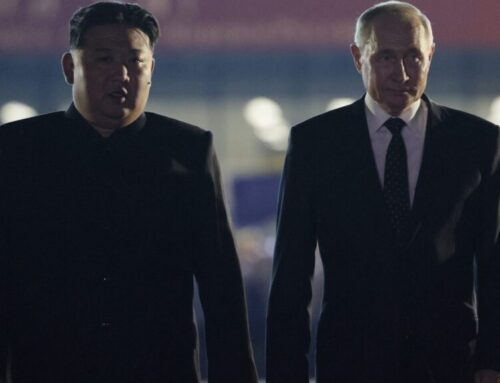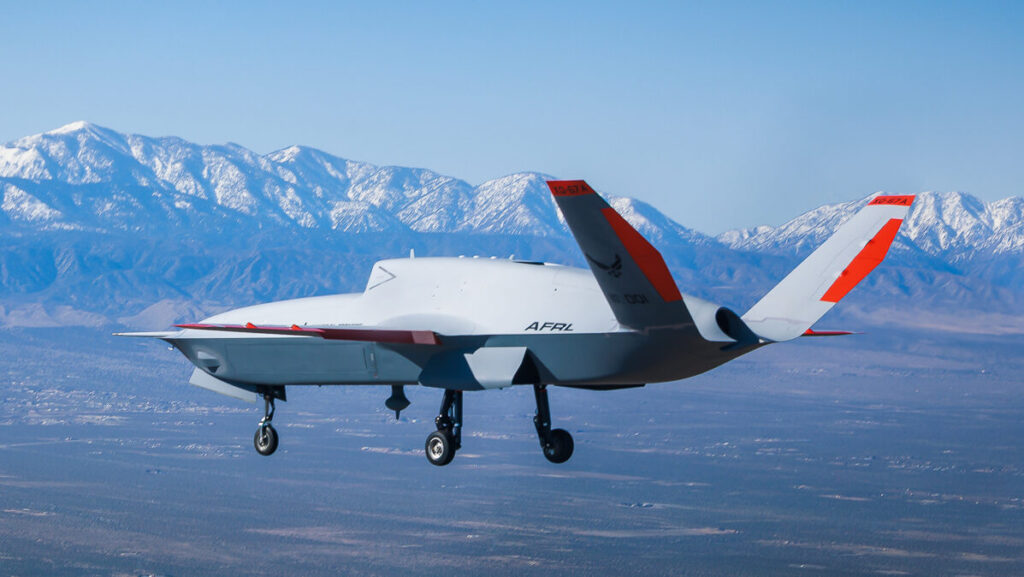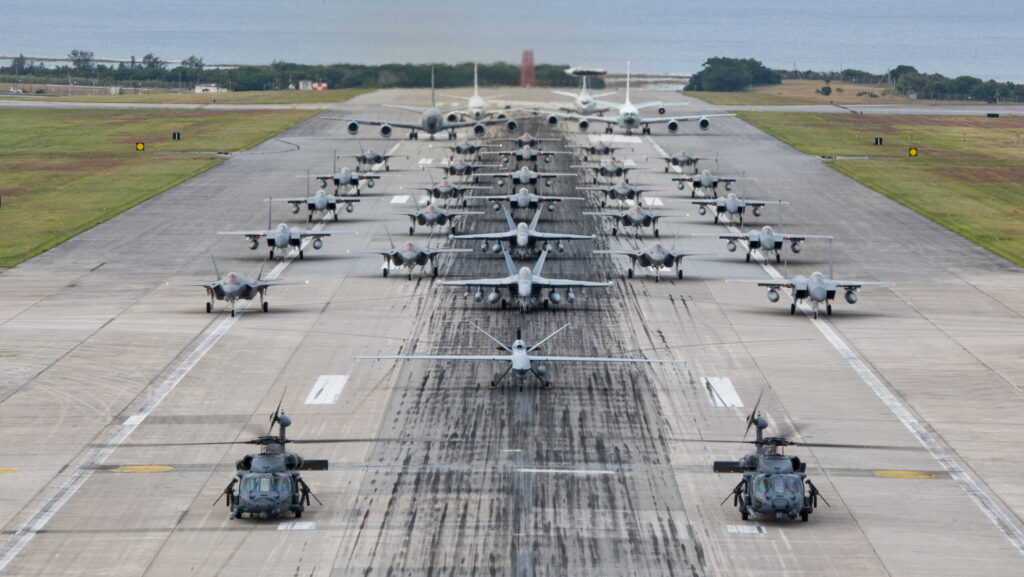A Boeing rendering of a next-gen fighter. (Boeing photo)
ST LOUIS, Mo., and WASHINGTON — It’s no secret that Boeing is in a bind. Regulators are scrutinizing the planemaker’s commercial business, whose woes have also attracted the attention of federal prosecutors. And ill-performing, fixed-price development contracts are forcing the company’s defense unit to hemorrhage cash, despite executives’ best efforts to staunch the bleeding.
At least for its defense business, Boeing executives are hoping that futuristic air dominance technologies can help turn things around. And to that end, the company has leaned forward, betting billions to build up new manufacturing facilities at the firm’s hub of fighter production in St. Louis, where the legacy F/A-18 line nears its end.
But in recent weeks, a potential problem has been brewing for Boeing’s ambitious expansion plans. A key customer driving the need for new facilities, the US Air Force, has started openly raising questions about the future of the service’s planned Next Generation Air Dominance (NGAD) fighter, casting doubt on what work may be available here in the Gateway to the West.
In an interview with Defense News, Air Force Secretary Frank Kendall today said the service was committed to developing a sixth-generation fighter, but that the concept needed to be revamped to be less expensive, with engines that would potentially be cheaper and less advanced. He would not say whether the Air Force will award an NGAD contract this year as previously planned.
“The family of systems concept of Next Generation Air Dominance is alive and well,” Kendall told Defense News. “I can tell you that we are looking at the NGAD platform design concept to see if it’s the right concept or not. … We’re looking at whether we can do something that’s less expensive and do some trade-offs there.”
For Boeing, the NGAD decision is especially critical. Rivals Lockheed Martin and Northrop Grumman have lucrative, decades-long airplane contracts in hand for the F-35 and B-21, while the long-term outlook of Boeing’s F-15EX production line largely depends on securing foreign customers.
In essence, Boeing’s defense unit would get a needed shot in the arm if it secures a major profit-making franchise to offset losses on programs like KC-46 and the new Air Force One planes. A victory would additionally ensure it retains the engineering talent necessary to keep up with competitors churning out stealth planes.
And while future production awards for drone wingmen known as Collaborative Combat Aircraft (CCA) could still be on the table, the Navy has deferred plans to develop its own sixth-generation fighter, leaving the Air Force’s NGAD contract as the only immediate opportunity to rejuvenate Boeing’s defense business.
“Yeah. I mean, we’re at risk,” Steve Nordlund, the head of the company’s air dominance unit, said in a June 26 briefing with reporters when asked about uncertainty stemming from the Air Force’s mixed signals, as well as potential changes in military strategy or the political environment. “But you take it one day at a time.” (Like other media, Breaking Defense accepted accommodations from Boeing for the visit.)
Somewhat awkward for Nordlund is that Boeing can’t officially confirm its involvement in the NGAD competition, though it’s widely believed the company is facing off against Lockheed for the high-profile contract. Still, Nordlund was clear that he believed the US needs greater production capacity for air dominance if it wants to stay ahead of China.
“I’d like to think that there’s gonna be a next generation,” he said. “So the question is the when, and then the who.”
Some onlookers are concerned that if NGAD is canceled, the Defense Department could eventually lose Boeing as a producer of fighter aircraft, leaving Lockheed as the only game in town.
“If you go down this route, with F-15EX nearing the end and F/A-18 [sunsetting], you’re left with one company that produces fighter jets,” said Stacie Pettyjohn, the director of defense programs at the Center for a New American Security.
But faced with a laundry list of must-pay bills like the B-21 and Sentinel intercontinental ballistic missiles, the Air Force may have little choice but to harvest NGAD for cash, multiple people with knowledge of the situation said.
“They are hard screwed,” said one source close to the Air Force.
Construction of Boeing’s planned factory for advanced combat aircraft. (Boeing photo)
Making Some Big ‘bets’
The expectation had been that NGAD would be awarded sometime this year, with service leaders talking up the program as key to the future of military aviation — while outside voices noted that the two contenders for the program present imperfect options.
With Lockheed struggling to overcome production issues on the F-35 and Boeing mired in myriad technical and supply chain problems on its own defense aerospace programs, the NGAD downselect amounts to “the worst choice the Air Force ever could have been forced to make,” said Richard Aboulafia, managing director for AeroDynamic Advisory and a longtime critic of Boeing.
“Do you hand the monopoly on fifth- and sixth-generation fighters to Lockheed? Or do you hope that Boeing, which seems to be trying to decide if rocks are still edible, somehow could execute?” he said, adding that it’s unclear whether the Boeing has a design team capable of developing a new advanced aircraft.
Still, NGAD appeared to be nearing a downselect decision this summer when, seemingly out of nowhere, both Kendall and service chief Gen. David Allvin in mid-June raised the specter that the program may need to be delayed or outright cut.
That’s potentially bad news for industry, which has been beefing up engineering and development teams with new hires, designing and flying NGAD demonstrator aircraft, and making large capital investments in new facilities where the sixth-generation jets would be built using the latest manufacturing processes.
Perhaps no one has made as public a bet on winning NGAD as Boeing, even if the company may not say it outright. In St. Louis, Boeing has invested an estimated $1.8 billion on a new manufacturing center dubbed an advanced combat aircraft facility, a 1.1 million square-foot building expected to be complete by 2026.
Down the road will be a new post-assembly center, where Nordlund said new aircraft will get their “last touches.” Those aircraft would then proceed to a new delivery center that will be built on the grounds of a defunct McDonnell Douglas delivery building. All facilities are co-located with St. Louis Lambert International Airport.
Further west, in Mesa, Arizona, Boeing broke ground on an advanced composite fabrication center, which would make components for future combat aircraft out of advanced composite materials. And in Daytona Beach, Boeing recently announced a new engineering hub at Embry-Riddle Aeronautical University that the company says will focus on “military aircraft programs and advanced technology capabilities.”
Intended for classified programs, Boeing’s new combat aircraft factory and attendant facilities could theoretically be repurposed for other work like commercial projects, according to Nordlund. “We’re early enough where that’s possible, but to be honest with you, that is not the conversation we’re having internally,” he said.
Analysts were at odds over how an NGAD cancellation would ultimately affect Boeing and the rest of the industrial base.
RELATED: NGAD uncertainty won’t impact GCAP next fighter in Europe, say analysts
Pettyjohn said Air Force leaders need to carefully think through repercussions to the defense sector should they move away from NGAD. Those considerations are echoed by four congressional staffers and industry officials who spoke with Breaking Defense and voiced concerns about industry consolidation, specifically citing Boeing and the engine makers. (A separate contest, known as Next Generation Adaptive Propulsion, has GE Aerospace and Pratt & Whitney battling to develop the engine to power NGAD.)
One aide said the decision to cancel NGAD “could have a crippling effect on the entire industrial base.”
There is “supreme angst about Boeing’s ability to deliver,” on the management and production elements of the NGAD, said one source close to the Air Force. But on the other hand, there are “pretty seismic implications for Boeing if they don’t get it.”
In St. Louis, Boeing’s current production efforts are a bit of a mixed bag. The company intends on shuttering its F/A-18 Super Hornet line in 2027, and while Air Force plans to stop buying F-15EXs after fiscal 2025, a big order from Israel for up to 50 jets could keep that line going, along with others like Indonesia and potential customers like Poland.
And while company officials say Boeing will eventually make money selling Air Force trainer jets and the Navy’s MQ-25 tanker drone, those fixed-price programs have taken more than $2 billion in reach-forward losses, most recently with a $94 million charge for the T-7 in the first quarter of the year.
However, not all analysts agreed that NGAD remains existential to Boeing’s defense business.
“I don’t think there was any guarantee at all that Boeing was going to get this. I think it represented hope,” Aboulafia said. “But on the other hand,” if NGAD is canceled, “frankly, there’s a good chance there’s more F-15s” procured by the Air Force, as it may need to boost its fleet of air superiority fighters.
The backlog of hundreds of T-7 trainers — which Boeing is aiming to export at some point — and potential foreign sales of the F-15EX can sustain Boeing’s St. Louis production lines until the Navy or Air Force come around with a requirement for a new combat aircraft, said J.J. Gertler, an aerospace analyst at the Teal Group.
One future opportunity for Boeing is the Air Force’s CCA program. The US planemaker failed to win a contract to produce prototype drones under the program’s first increment, but it could try again during a subsequent installment of the effort set to begin later this year.
Another option the Air Force could take to try to retain industrial capacity is for aircraft producers like Lockheed and Boeing to win future contracts that would allow them to manufacture other company’s designs, Gertler said. That premise was championed by former Air Force acquisition czar Will Roper, who wanted to separate NGAD design from production in order to manufacture aircraft as efficiently and cheaply as possible.
“If you’re going to do CCA in the kind of numbers the Air Force is talking about, it’s going to be hard for anybody to be the sole producer on it,” Gertler said. “The Air Force is open to ideas like one person building somebody else’s design. And Boeing wants to be in position to be that efficient producer of whatever comes along.”
Asked about that possibility, particularly for programs like CCA, Nordlund said it depends on the fine details.
“I think the devil is in the details on that, because what it really gets into — well, there’s a lot of things that gets into — but one is, what is the IP [intellectual property] that is needed? And, you know, who truly owns that IP?” he said.
Overlooking the company’s next-gen construction from the seventh floor of Boeing’s Building 100 on a rainy day in St. Louis, Nordlund noted the need to keep investors committed to the beleaguered aerospace giant, especially considering the cost of expansion.
“We just don’t do this willy-nilly,” he said. “We’re out there with a plan. And we’re thinking about that plan every day. And as we learn new news, we may pivot, we may not.”
As NGAD’s future hangs in the balance, Nordlund said he hopes that Boeing’s proactive approach to laying the groundwork for the next generation of aircraft will be well received by the Pentagon.
“We have to make some bets. And we’ve listened to our customer, and we’re leaning forward,” he said. “And I hope our customer appreciates that.”
Storm clouds gather over Boeing’s St. Louis headquarters. (Michael Marrow/Breaking Defense)
A Potential Political Battle
The decision of whether or not to continue on with NGAD as planned could ultimately come down to politics.
One source familiar with the Air Force’s thinking noted that there are multiple decision points this year in which the NGAD decision could be re-evaluated. Chief among those is the November presidential election, which could lead to the onramp of new Air Force civilian leadership that may find other bill payers to sacrifice in order to keep NGAD alive.
While no lawmakers have publicly weighed in yet on the Air Force’s wavering commitment to a new sixth-generation fighter, a congressional aide for Sen. Eric Schmitt, R-Mo., underscored the importance of the program for Boeing’s facilities in St. Louis.
“He’d love to see Boeing get the NGAD contract, but from a broader perspective, just making sure the NGAD program continues is critical so that we maintain that air superiority in future conflicts, so that we build up the industrial base,” the aide said.
Another Schmitt aide added that program cancellation would “send the absolute wrong message to industry,” and could have a “chilling effect” on defense companies willingness to make future investments.
Others on Capitol Hill are already ringing alarms about what is seen as a shocking reversal by service leaders that opens the question of how the Air Force will do the air superiority mission going forward.
One aide said the decision contradicts what service leaders have told lawmakers for years.
“For a decade, we have heard senior Air Force leaders tout the need for a sixth generation capability to compete with China,” the aide said. “It is beyond comprehension that the Air Force would suddenly and inexplicably walk away from that and tell us that unproven CCA is the answer.”
But while Congress has been broadly supportive of NGAD so far, concern over the service’s shrinking number of fighters could bolster the argument that continuing NGAD would come at the expense of the rest of the combat air force and leave it without the numbers needed to fight China.
“For now, it is evident that cost-effective capacity solutions — such as the Collaborative Combat Aircraft — will be paramount for the Air Force to address its force structure challenges,” a different staffer said.
Both the House and Senate versions of the FY25 authorization bill contain language that would require the Air Force to submit a report about its fighter force requirements, with the House seeking insight on how NGAD fits into those plans and the Senate requesting more information on how the service plans to conduct the air superiority mission into the 2030s and 2040s.
Aside from Schmitt, another vocal supporter of NGAD is Mississippi Sen. Roger Wicker, currently the top Republican on the Senate Armed Services Committee, who is favored to take the SASC gavel if the GOP wins the Senate in November elections.
Wicker called for a “generational” increase to defense spending, arguing in a white paper released in May for an expanded buy of CCA, which Wicker said is necessary to keep the Air Force out of an “accelerating force structure death spiral.” However, he noted that increased investment in the combat drone program should not come at the expense of NGAD.
“Even with CCAs, the Air Force can and must field the Next-Generation Air Dominance program at the planned numbers,” he wrote.


